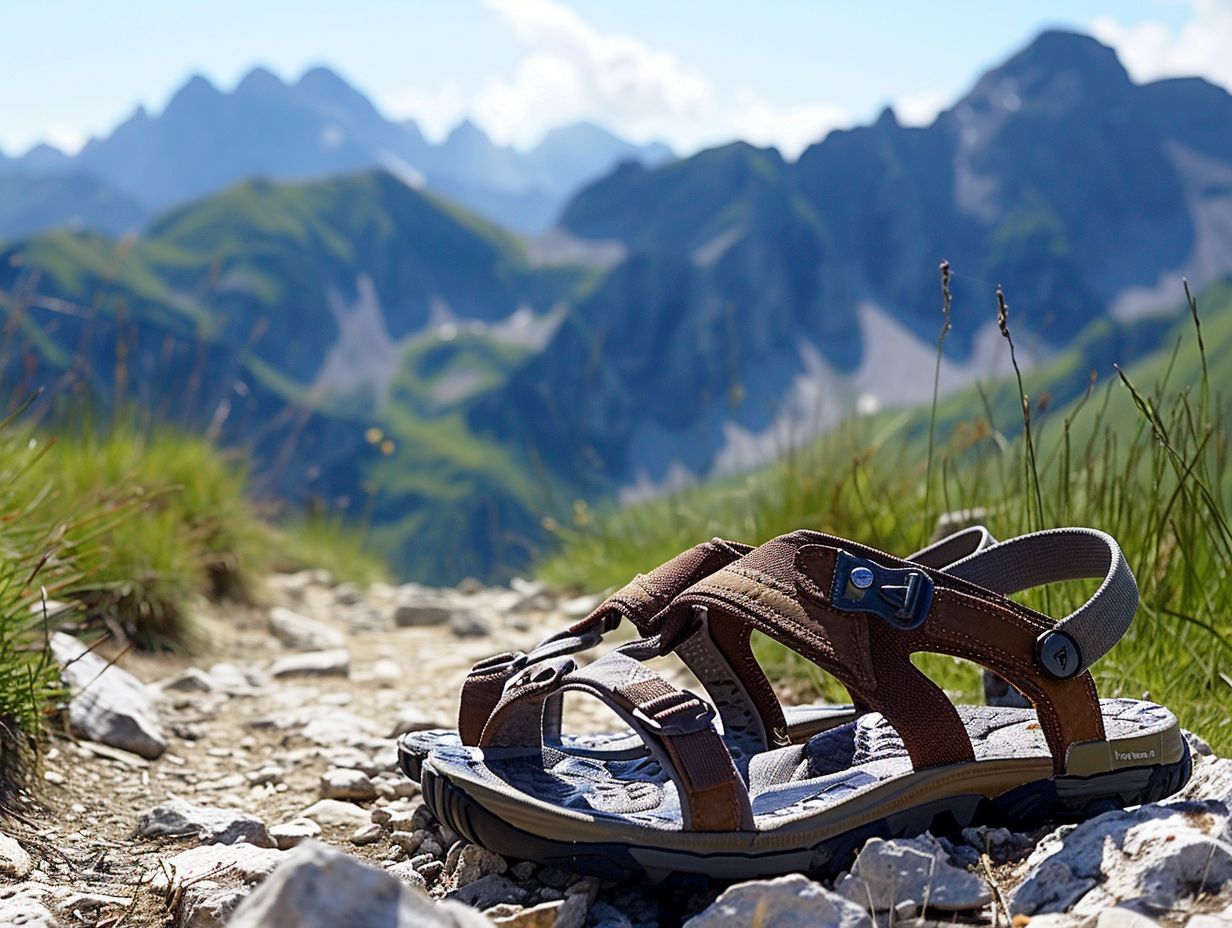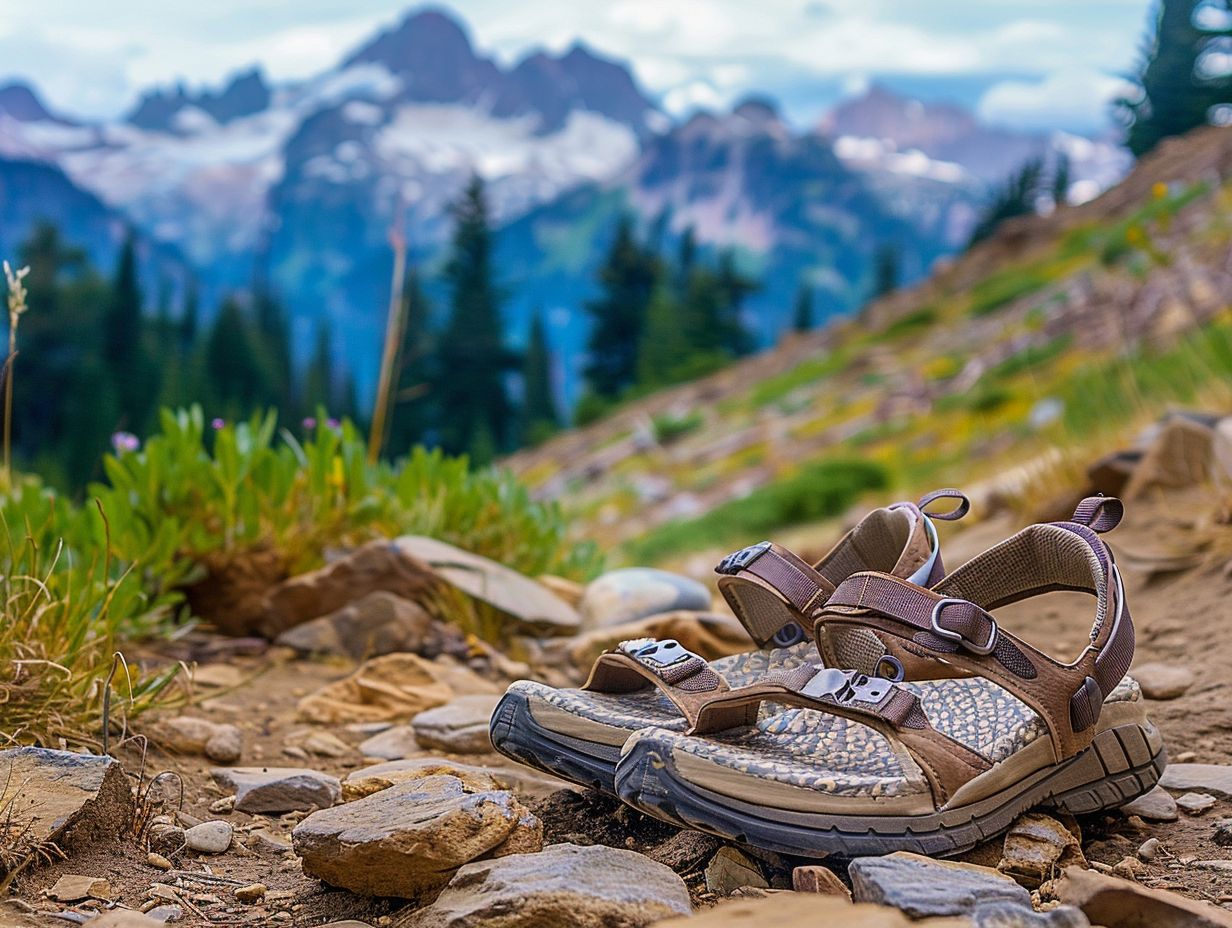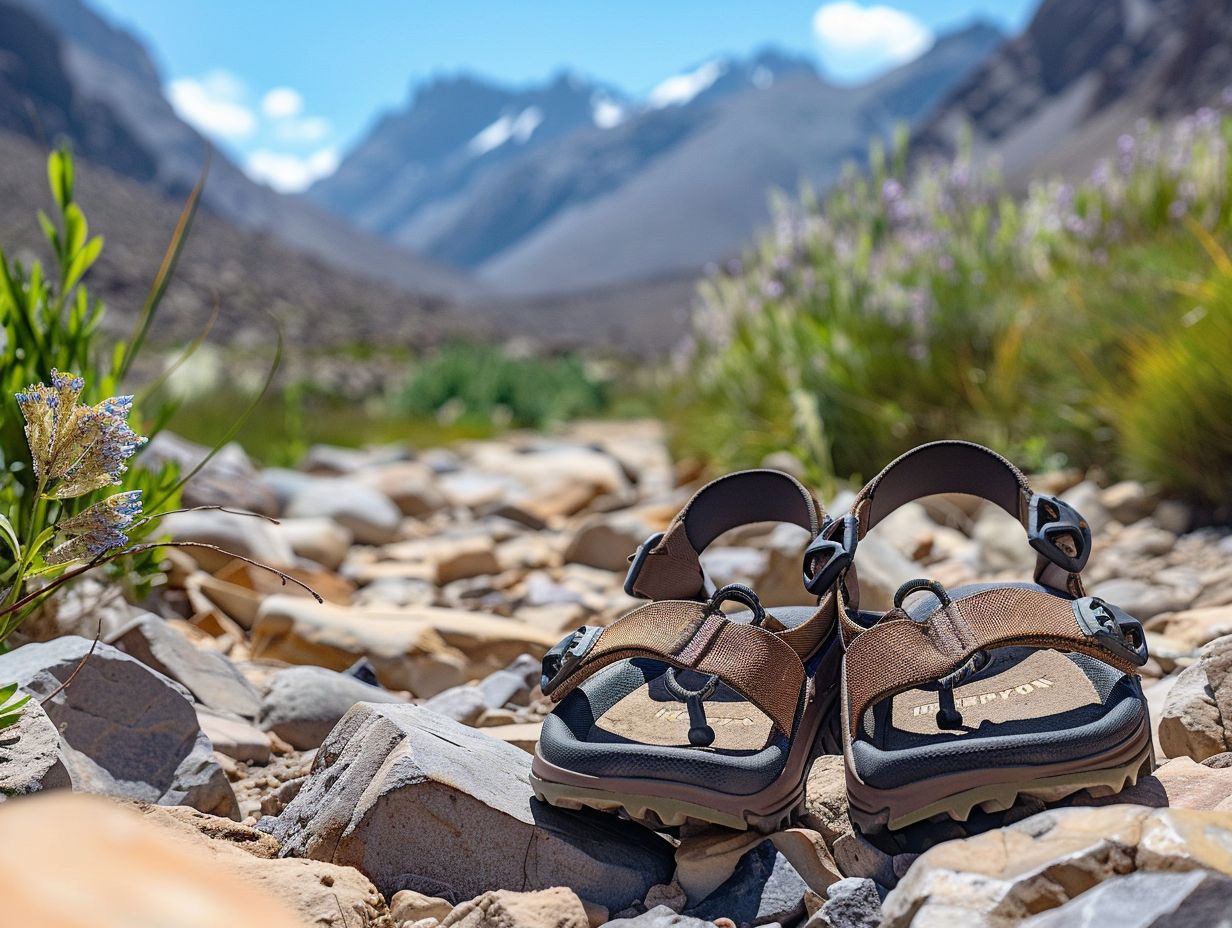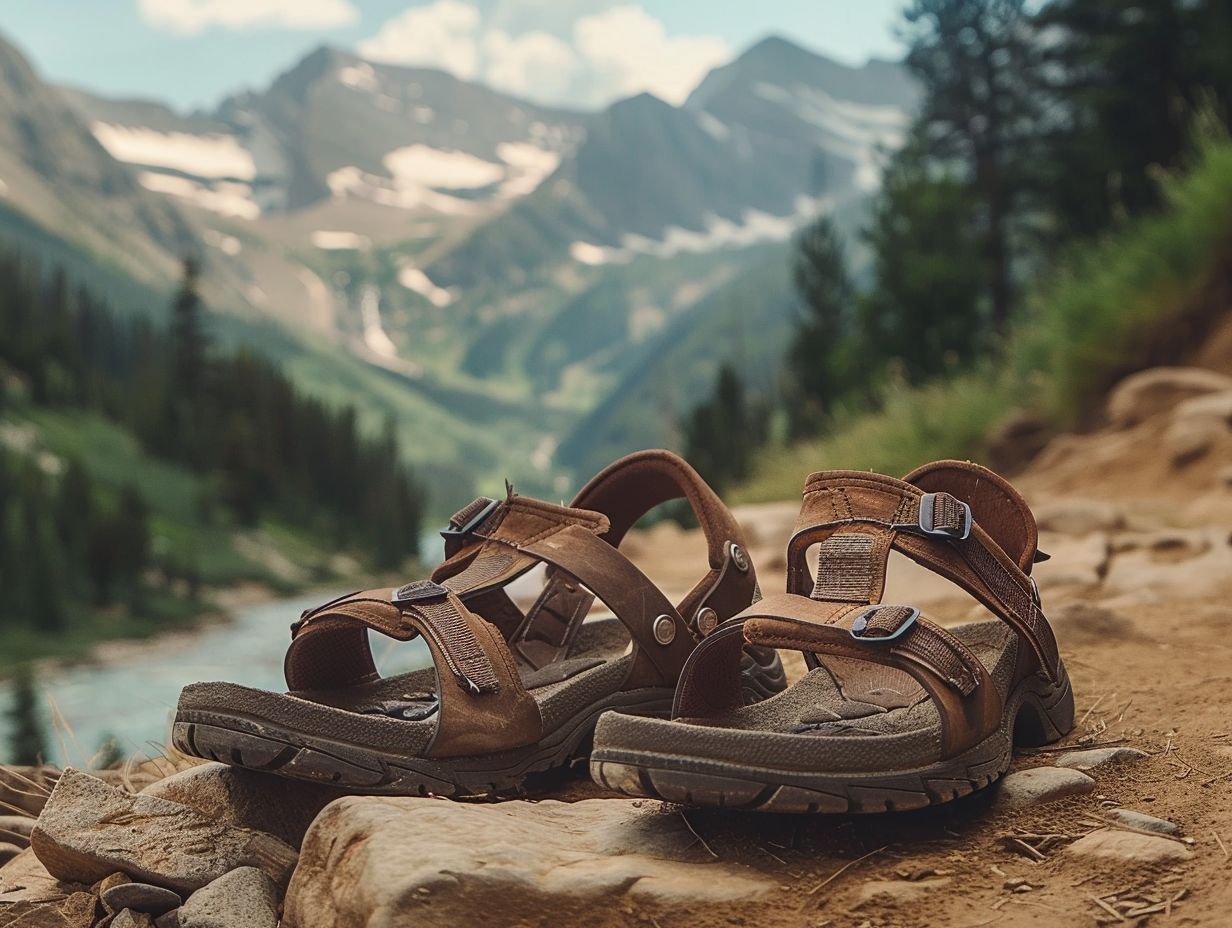When you’re hitting the trails, hiking sandals are a go-to option for folks who want comfy and versatile footwear.
Let’s look at why hiking sandals are all the rage, from their lightweight feel to their great grip and quick-drying powers. But, hey, they’re not perfect – we gotta talk about how they might not offer as much ankle support and protection from the elements.
Looking for some advice on picking the perfect hiking sandals and making sure they feel just right? Whether you’re a seasoned pro or just dipping your toes into hiking, figure out if hiking sandals are your best bet for your next outdoor escapade.
What Are The Benefits Of Hiking Sandals?

Hiking sandals can be your best buddy when you’re out and about exploring the great outdoors. Packed with a mix of comfort, durability, and practicality, these sandals are perfect for all your summer hikes and outdoor escapades.
They’ve got your back on those long days trekking through the trails, providing solid support and cushioning for your feet. Thanks to their ventilation system, your feet stay cool and dry, even when the sun is blazing. Plus, their lightweight design gives you the freedom to move around easily, whether you’re navigating rocky paths or lounging on sandy beaches.
From rugged terrain to peaceful nature trails, hiking sandals strike the right balance between keeping you comfy and performing at your best.
1. Lightweight and Breathable
When you’re out on the trails, you want hiking sandals that are both comfy and breathable. These sandals are designed to keep your feet happy while still giving them the coverage they need for all your outdoor activities.
Breathability is key here – it lets all that heat and sweat escape from your feet, so you can avoid any discomfort or pesky blisters on those long hikes. With materials like mesh uppers and quick-drying fabrics, your feet will stay cool and dry by letting that fresh air circulate around them. And let’s not forget about the lightweight design – it helps reduce fatigue in your feet and legs, so you can keep on trekking for miles without feeling worn out.
By choosing hiking sandals with these features, you’ll have a much better time out on the trail. Your feet will stay cool, comfortable, and well-supported through all your adventures.
2. Good Traction and Grip
One of the key advantages of hiking sandals is their excellent traction and grip, ensuring stability and support on various terrains, including hiking trails and wet surfaces.
These features will enhance your hiking experience by giving you the stability you need to tackle tough landscapes with confidence. Well-designed hiking sandals with their sturdiness and slip resistance not only prevent slips and falls on tricky surfaces but also provide a comfy and secure fit for those long hikes. With reliable traction, you can explore all kinds of terrains with peace of mind, knowing your footwear is there to keep you safe and steady every step of the way.
3. Quick Drying
When you’re out on the trails, hiking sandals are your best friend. They dry super fast, perfect for sandy paths or splashing through water while keeping your feet cool and supported.
These sandals really shine when you unexpectedly hit water or get caught in the rain. They dry in a snap, so you won’t be stuck with soggy feet or blisters. Plus, they’re waterproof, keeping your feet dry and comfy in wet conditions, reducing the chances of chafing or icky fungal infections.
And don’t worry about your feet getting all sweaty – these sandals are still breathable, so they’ll keep you cool and fresh, steering clear of any funky odors or skin troubles.
4. Comfortable for Long Distance Hiking
When you slip into a pair of hiking sandals, you not only feel cozy but also ready to take on the great outdoors. These sandals are built to last, with top-notch arch support, cushioning, and flexibility that are perfect for those long hikes and outdoor escapades.
Thanks to their tough design and premium materials, hiking sandals can handle whatever tough terrain or challenges come your way during your adventures. The arch support they provide keeps your feet properly aligned, easing any strain or discomfort on those lengthy treks. Plus, the cushioning in these sandals absorbs the impact, giving your feet a soft and supportive foundation. With this winning combo of support and comfort, hiking sandals are the go-to choice for anyone wanting to explore the outdoors for hours on end while keeping their feet happy and performing at their best.
What Are The Drawbacks Of Hiking Sandals?
When you’re out on the trails wearing hiking sandals, you’ve got to consider both the pros and cons. Sure, they’re comfy and breathable, but they do have their downsides too.
For one, the limited ankle support can be a real bummer, especially on those rocky, uneven paths where you’re more likely to twist an ankle. And don’t forget about the open design leaving your feet vulnerable to all sorts of elements like rocks, branches, and bugs – not exactly ideal for a carefree hike.
In those situations where stability and protection are key, you might want to swap out those sandals for some trusty hiking shoes or boots with more coverage and support.
1. Limited Ankle Support
When you’re hitting the trails in hiking sandals, one thing to keep in mind is their limited ankle support. This might be a concern for you, especially if you have specific foot conditions or need that extra support for your foot’s mechanics to work right.
Without that proper ankle support, you’re putting yourself at risk for wobbles and potential injuries as you navigate rough, uneven terrain. Your ankles are key players in keeping you balanced and steady, especially when the ground is wonky or you’re lugging around a heavy backpack.
If you’re not getting the ankle support you need, you could find yourself dealing with overpronation or supination, throwing off your feet’s natural alignment and causing some discomfort or pain. Plus, this lack of support could make existing issues like plantar fasciitis or Achilles tendonitis even worse, since these conditions need good cushioning and structure to keep from getting strained further.
That’s why it’s crucial for you to think about where you’re hiking and how tough the trek will be when you’re picking out your footwear. Make sure you’re getting the ankle support necessary for those times when you need it most.
2. Less Protection From Elements

Regarding hiking sandals, they offer less protection from the elements than hiking shoes. This means they might not be the best choice for rough terrain, and you’ll need to pay extra attention to taking care of your feet and preventing blisters.
For example, without toe protection in hiking sandals, your toes are at risk of getting banged up by rocks or roots, which could lead to injuries. Plus, navigating through bumpy and uneven ground in sandals can be tough since the open design leaves your feet more exposed to cuts and scrapes.
So, before you decide to go with hiking sandals, make sure you consider the environment and whether they’ll provide enough protection for your feet. This way, you can ensure you’re comfortable and safe during all your outdoor adventures.
3. Not Suitable For All Terrain
If you’re planning to hit the trails, hiking sandals might not be the best choice for every type of terrain. They work great for leisurely nature walks and easier paths, but rocky or uneven surfaces might call for more foot coverage.
Hiking sandals really shine in sandy environments where you don’t need a ton of protection, and staying cool is key. They keep your feet ventilated, preventing them from overheating on those warm weather hikes. Their lightweight and open design are all about keeping you comfy and cool.
But if you’re tackling tough terrain with sharp rocks, slippery slopes, or other hazards, you might want to swap those sandals for closed-toe shoes or sturdy hiking boots. They offer extra protection and stability to keep you safe and steady on those more challenging trails.
How To Choose The Right Hiking Sandals?
When you’re picking out the perfect pair of hiking sandals, there are a few key things to keep in mind. First off, consider the type of terrain you’ll be tackling. If you’re hitting rocky trails, go for sandals with tough soles and toe protection. But if you’re wading through sand or splashing in wet areas, look for water-resistant sandals with good grip.
Comfort is key for a happy hike, so make sure your sandals have decent arch support and cushioning. And don’t forget about fit – you want to avoid those pesky blisters and discomfort on long treks.
Choosing materials wisely can also make a big difference. Think about going for synthetic fabrics or waterproof leather to boost your sandals’ durability and performance in all kinds of conditions.
1. Consider The Terrain
When choosing hiking sandals, you need to think about the terrain conditions you’ll encounter. This way, you can make sure that the sandals give you the stability, grip, and support you need for your outdoor escapades.
If you’re tackling rugged mountain trails with rough surfaces and rocky terrain, go for hiking sandals with tough outsoles and top-notch traction, like the ones with Vibram soles. These sandals will give you excellent grip and durability to handle those challenging terrains like a pro.
On the flip side, if you’re going for a casual hike on flat or well-kept trails, you might want to consider lightweight and flexible sandals with good cushioning. By understanding what your hiking spots demand, you can pick the perfect sandals for a cozy and safe outdoor journey.
2. Look For Good Traction
Make sure you prioritize hiking sandals with solid traction and grip to give yourself a sturdy foundation for your outdoor adventures, especially when you’re facing tough conditions or slippery surfaces where you need that extra slip resistance.
These features are crucial for keeping you stable and preventing any embarrassing slips and falls, which can be super risky when you’re out hiking. Good traction doesn’t just boost your performance on rough terrain, it also gives you peace of mind as you navigate through tricky landscapes.
By investing in hiking sandals that offer top-notch traction, you’ll feel confident taking on all sorts of outdoor activities without sacrificing comfort or safety. Whether you’re trekking up steep slopes, crossing streams, or maneuvering through rocky trails, having reliable grip under your feet can totally transform your hiking experience.
3. Check For Comfort and Fit
When selecting your hiking sandals, prioritize comfort and fit above all else. Make sure they offer sufficient arch support, cushioned footbeds, and are the right size to keep your feet happy and comfy.
Having proper arch support in your hiking sandals is key to keeping your feet aligned and reducing strain on your arch and heel. Cushioned footbeds are a must for shock absorption during those long hikes. And don’t forget about sizing – correctly sized sandals will help prevent blisters and discomfort.
As you try on your hiking sandals, remember to leave enough space between your toes and the front of the sandal to avoid any friction. Take a stroll in them to check for any rubbing or pressure points, and ensure the straps are adjustable for a snug, but not too tight, fit. Your feet will thank you later!
4. Consider The Material
Regarding hiking sandals, the material choice can make or break your outdoor adventures. The durability, foot protection, versatility, and overall quality all depend on what those sandals are made of.
You need hiking sandals that can handle tough terrains and unpredictable weather. Choosing the right materials is key to a comfy and safe hiking experience. Vibram rubber soles are a solid choice for excellent grip on slippery surfaces, while EVA foam midsoles provide cushioning and shock absorption to keep foot fatigue at bay. Synthetic uppers like polyester or nylon boost breathability and quick-drying features, so your feet stay cool and dry during those long hikes. By picking the right combo of these materials, you’re not only ensuring longevity but also guaranteeing top-notch performance for all you outdoor enthusiasts out there.
Are Hiking Sandals Good For Everyone?

If you’re thinking about hiking sandals, you should know they come with a bunch of perks, but they might not be the best fit for everyone. Seasoned hikers, folks looking for a more relaxed outdoor experience, and people with specific foot problems can get the most out of these sandals.
For those who’ve spent a lot of time hitting the trails, hiking sandals hit the sweet spot when it comes to breathability, grip, and support. The open design lets your feet breathe, so they stay cool and comfy, even on those long hikes. Plus, the sturdy soles keep you steady on all kinds of terrain, giving you the confidence to tackle those tough trails.
If you’re more of a casual outdoor adventurer, hiking sandals could be right up your alley. They’re super versatile and easy to slip on, making them perfect for anything from leisurely strolls to easy hikes. With hiking sandals, you get the comfort and protection you need without lugging around those bulky hiking boots.
1. For Experienced Hikers
You can take your hiking game to the next level by making the most of hiking sandals for your outdoor escapades. These sandals are packed with top-notch features designed specifically for your needs and preferences.
When you slip on these specialized sandals, you’ll feel the freedom of movement and breathability they offer compared to clunky hiking boots. The materials used are both tough and flexible, giving you the traction and stability you need to conquer any terrain effortlessly. Plus, the open-toe design keeps things breezy and prevents your feet from turning into little ovens during long hikes. With adjustable straps and secure closures, you can tweak the fit to your liking, ensuring maximum comfort and support and keeping blisters and discomfort at bay.
2. For Shorter Hikes
For your shorter hikes and casual outdoor adventures, hiking sandals are your go-to choice. They’ve got the grip, cushioning, and comfort you need for a laid-back and enjoyable time, perfect for wearing on nature walks or sandy trails.
Hiking sandals are designed to keep you steady on those bumpy paths, giving you a firm footing as you explore the great outdoors. The cushioned footbeds soak up the impact and ease the strain on your feet, so you can keep walking for a while without feeling achy. Plus, the adjustable straps let you tailor the fit to your liking, boosting your overall comfort and support. With their breathable materials and water-resistant features, hiking sandals are versatile beasts that can take you from tough trails to lazy beach strolls without breaking a sweat. They’re a convenient and dependable choice for all sorts of outdoor activities.
3. For People With Foot Issues
If you’ve got some foot issues to deal with, hiking sandals could be your new best friend. They’re made to keep your feet happy and healthy, giving you the arch and orthopedic support you need while tackling common foot problems that pop up during outdoor fun.
These special hiking sandals come with all sorts of features tailored to different foot conditions like plantar fasciitis, overpronation, or high arches. They’re all about giving you the right support and cushioning, so you can enjoy your outdoor escapades without any pesky discomfort or pain. Plus, the materials they’re made of are usually water-resistant, tough, and breathable, so you’re covered on all fronts. With adjustable straps and customizable insoles to dial in that perfect fit and support, hiking sandals are the way to go for anyone looking for foot-friendly footwear options.
Tips For Wearing Hiking Sandals Comfortably
When you’re gearing up for a hike in sandals, make sure you’re getting the most out of them with these tips to keep your feet happy and well-supported. Whether you’re worried about sizing, foot care, or buying online, these suggestions will help you navigate the great outdoors comfortably.
Make sure you’re picking out hiking sandals with tough soles and adjustable straps to keep your feet secure and comfy. Long hikes call for good arch support, so keep an eye out for cushioned footbeds or contoured insoles.
Don’t forget to give your feet some love by moisturizing and trimming your toenails before slipping on those sandals. This will help prevent any discomfort or annoying chafing. And if you’re buying online, check out the size guides from the manufacturer and read up on customer reviews to get the lowdown on sizing and overall comfort.
Different terrains call for different features, like sturdy outsoles for rocky trails or water-friendly materials for those amphibious adventures. By considering these details, you can get the most out of your hiking sandals no matter what outdoor activities you’ve got planned.
1. Wear Appropriate Socks
Pairing hiking sandals with appropriate socks enhances your foot protection, comfort, and anatomical alignment, ensuring a more enjoyable and supportive outdoor experience.
The right socks can act as a barrier against blisters and provide cushioning for your feet, reducing the impact of rough terrains. In addition, proper socks help in maintaining the natural alignment of your foot, preventing strain and fatigue during long hikes.
When choosing socks, consider factors like material, thickness, and height to cater to your specific hiking conditions. For warm weather, opt for moisture-wicking socks to keep your feet dry, while colder climates may require insulated options for warmth. Ultimately, finding the perfect socks can make a significant difference in your hiking adventures.
2. Break Them In Before Long Hikes
Before you head out on those long hikes, make sure you break in your hiking sandals first. This will ensure your feet stay comfy, prevent any nasty blisters, and help your feet get used to the sandal design for a smooth and blister-free experience.
Taking the time to properly break in your hiking sandals can really make a difference in how your feet feel during those extended treks. Start by wearing them around the house for short periods to let your feet adjust to the new fit and materials. Gradually increase how long and how tough your wear them, maybe on shorter walks or day hikes, so your feet have time to get used to them. Keep an eye out for any hotspots or areas of discomfort and adjust the straps or lacing system to get the fit just right.
By easing into your sandals, you’re not just avoiding potential blisters but also getting your foot mechanics in sync with the sandal’s structure for better comfort and performance on the trails.
3. Use Toe Separators

Using toe separators can really help you out, whether you’re dealing with foot discomfort or just want to keep your feet healthy. They’re great for addressing common foot conditions, giving your feet some extra support, and preventing any potential foot problems that might pop up when you’re out and about in your hiking sandals.
When you pop on those toe separators with your hiking sandals, you’ll notice a big difference in how comfy and stable your feet feel, especially on those long treks or hikes. By making sure your toes stay in proper alignment, these separators can keep issues like bunions, blisters, and toe rubbing at bay. Adding toe separators to your foot care routine before and after your outdoor adventures can really help you out, improving your balance, easing pressure on your toes, and lowering the chances of foot troubles cropping up. So, if you’re big on outdoor activities, getting on board with toe separators is a smart move to keep your feet healthy and performing at their best.
4. Apply Sunscreen
When you’re out hiking in the sun with sandals on, make sure to slather on some sunscreen on your feet. It’s key to keep your feet protected and cared for, shielding them from those harsh UV rays and potential sunburn.
Sunscreen isn’t just for your face and arms – your feet need some love too! The skin on our feet is just as vulnerable to sun damage as the rest of our body, but it often gets neglected. So, before you hit the trails, don’t forget to apply sunscreen on your feet. This simple step can help prevent painful sunburns and keep your feet healthy in the long run. Look for a broad-spectrum sunscreen with an SPF of 30 or higher, and don’t forget to reapply every two hours or after swimming or sweating a lot. Your feet will thank you!
Frequently Asked Questions
Are hiking sandals good for long hikes?
It depends on the type of hike and personal preference. Hiking sandals are lightweight and can provide good traction, but they may not offer as much support as hiking shoes or boots.
Are hiking sandals good for water activities?
Yes, hiking sandals are great for water activities such as crossing streams or walking along the beach. They are designed to dry quickly and provide good traction on wet surfaces.
Are hiking sandals good for rocky terrains?
It depends on the type of hiking sandals. Some models have thick soles and toe protection, making them suitable for rocky terrains. It’s important to choose a pair with good grip and support for these types of trails.
Are hiking sandals good for people with foot problems?
Again, it depends on the individual’s needs and the type of hiking sandals. Some models offer arch support and cushioning, which can be beneficial for those with foot problems. It’s always best to try them on and see how they feel before committing to a long hike.
Do hiking sandals provide enough protection for my feet?
Hiking sandals are designed with protection in mind, but they may not offer as much coverage as hiking shoes or boots. It’s important to choose a pair with toe protection and a sturdy sole for added protection on rough trails.
Are hiking sandals good for all types of weather?
Hiking sandals are best suited for warm and dry weather. They are not recommended for cold or wet conditions as they do not provide enough insulation or waterproofing. It’s important to choose appropriate footwear for the weather conditions to ensure comfort and safety on the trail.

